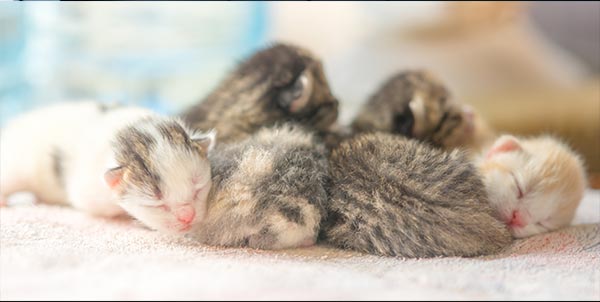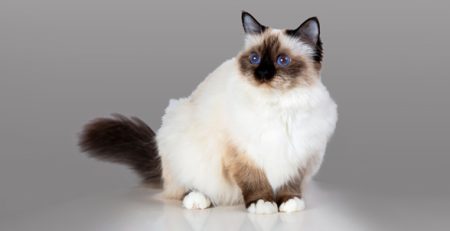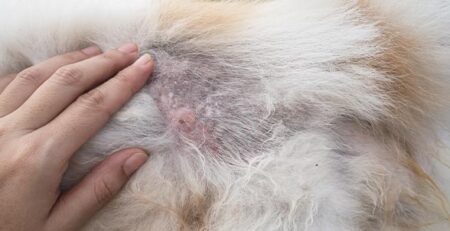Table of Contents
Cat birth: how long labor lasts, in which cases to intervene, how to handle newborn kittens, and how long they should stay with their mother.
If your pregnant cat is about to give birth and you’re wondering what to do to help her, know that female cats who give birth are usually completely autonomous.
As a rule it is good for you to be present but discreetly, without disturbing and intervening only if you realize that there are obvious complications and in case of need.
How does a cat behave before giving birth?
If the cat lies on her side, starts meowing, has labored breathing, and her abdomen begins to contract, this is it: labor begins.
The contractions, at first more widely spaced, will be increasingly closer together until the waters break.
Waters break, and within 20 to 30 minutes the cat expels the first kitten and then the others in succession.
Half an hour or more may pass between expulsions.
Depending on the number of kittens being born, delivery can take an average of 2 to 4 hours unless there are difficulties.
Difficulties that might occur during mother cat birth: dystocia
Dystocia, or the inability of fetuses to expel spontaneously, is one of the most common problems that can occur during a cat’s birth.
Two types of dystocia are distinguished:
– Obstructive dystocia occurs when there is severe disproportion between the size of the kittens and the size of the maternal birth canal, which is inadequate for the passage of the kittens.
– Functional dystocia, also called inertia, is the most common cause of difficult delivery in cats and results from the inability of the uterus to produce contractions (in some cases, contractions are there but are weak or infrequent).
When to suspect dystocia?
Suspicion of dystocia should be considered:
- When delivery does not begin at the expected end of gestation
- When after more than 30 minutes of strong unproductive contractions, fetal expulsion does not follow
- When the interval between the expulsion of consecutive fetuses exceeds 2-4 hours
- When hemorrhage occurs during delivery or blackish-green flows are expelled that are not followed by fetal expulsion;
- When the cat shows signs of malaise or discomfort.
In such cases, it is essential to contact the veterinarian immediately.
Kittens are born wrapped in amniotic sac, joined to mother cat by umbilical cord
As soon as she delivers the kittens, mother cat releases the kittens from the amniotic sac and cuts the umbilical cord with her teeth.
Then lick each newborn kitten to clean and dry it, urge its breathing and activate circulation.
Moved by instinct, mother cat will eat amniotic sacs, umbilical cords and placenta.
Nature has provided that mother cat, unable to get away from the kittens, draws nourishment precisely from the placenta.
The placenta is very rich in those nutrients needed by the cat to recover from the exertions of childbirth and to nurse newborn kittens.
How to deal with a cat who has given birth?
When the cat has finished giving birth to all her kittens, she leaves mom and kittens alone.
Newborn kittens should not be touched at all.
Mother cat may not recognize them as her own and refuse to nurse them.
If you really have to handle them for any procedure, wear latex gloves.
Newborn pussycats are toothless, deaf and blind.
On the other hand, they are endowed with an excellent sense of smell and extraordinary instincts.
In fact, they immediately smell the scent of mother’s milk and head for mother’s udders without delay.
What if a kitten doesn’t latch on to mama cat’s udders?
In case a kitten is born weak and cannot suck from the cat’s udders, intervene by trying to open its mouth.
Introduce the nipple by holding it in place with two fingers.
Then, press lightly and let some colostrum out.
Colostrum is the milk of the first thirty-six hours, which is essential to protect the kitten against infection and disease.
Make sure mother always has enough milk and feed her properly.
What to do when kittens cannot be nursed by mama cat?
A kitten needs to eat regular meals at intervals of 2 to 6 hours, depending on age.
If artificial feeding is necessary, always ask your trusted veterinarian-.
Your veterinarian will tell you the specific puppy milk powder to use, the quantity, frequency and mode of administration.
The use of any milk other than powdered milk for infant cats should be categorically ruled out.
Ensures a comfortable environment for mother cat and kittens
During the first few days of life, kittens require no special attention other than to ensure that they have a quiet, hazard-free environment.
It ensures a fairly high room temperature, at least on a constant 22°C.
And again, take care that there are no drafts.
Kittens are not able to jump but are likely to try to climb.
Around two weeks kittens begin to grow baby teeth, and teething will be completed at about 2 months.
Ensures a comfortable environment for mother cat and kittens
At this time in their lives, puppies begin to discover the world.
This is the “educational” play phase, the one that only mama cat can impart.
It is important not to separate kittens from mother cat before they are two months old
Puppies spend most of their time sleeping and playing.
In fact, play, under the careful supervision of mama cat, is the puppies’ school of life: an early simulation of hunting, fighting and fleeing that prepares the young for independent management.
This is why kittens should not be detached from their mother until they are 60 days old.
For these and other tips and to monitor your cat’s pregnancy, please consult our Staff Veterinary Doctors who are always available to you.
In this regard, in case of need and urgency, we would also like to remind you that La Veterinaria Clinic is always open h24 every day including holidays and with First Aid service from 8 pm to 8 am.
For the joy of seeing them HAPPY











